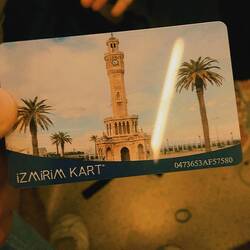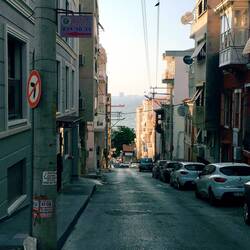- Visa resan
- Lägg till bucket listanTa bort från bucket listan
- Dela
- 20 jan. 2024
- ☁️ 17 °C
- Höjd över havet: 234 m
 TurkietİzmirYeni38°13’54” N 27°1’48” E
TurkietİzmirYeni38°13’54” N 27°1’48” E
Izmir, l’européenne
 20 januari, Turkiet ⋅ ☁️ 17 °C
20 januari, Turkiet ⋅ ☁️ 17 °C
Aujourd’hui, c’est blanchisserie !
Comme en Bulgarie, en Turquie aucune laverie self-service en vue ; il nous faut donc déposer notre linge chez un·e professionnel·le et revenir le chercher une fois le travail accompli. Nous faisons la connaissance d’une agréable petite femme au visage lumineux qui nous propose de repasser 4 h plus tard, royal ! 19 h sonne et nous voici de retour, mais le linge n’est pas encore tout à fait sec. Nous nous voyons offrir l’hospitalité (la blanchisserie se révélant être le hall d’entrée de la maison familiale). Son fils nous apporte gentiment le çay et de petits chocolats pour patienter ! Ne parlant pas anglais, notre hôte cherche en vain la deuxième chaussette... de notre gant de toilette en bambou ! Je lui mime l’usage de cet objet et la rassure sur le fait qu’il n’a pas d’acolyte et qu’elle n’a donc rien perdu ! Nous nous quittons sous de chaleureux au revoir, notre bienfaitrice formant un mignon cœur avec ses doigts. 💛
Depuis quelques jours, nous sommes très surpris·e·s par le nombre de petites caravanes similaires en forme de coquilles d’escargot à la grande baie vitrée, de vans de notre gabarit et de vieux bus rétro aménagés croisés sur les spots que nous fréquentons, tous immatriculés en Turquie. Dans de petites bourgades sur le front de mer, comme en ville près des axes routiers très passants, leurs propriétaires semblent y vivre de manière permanente. Nous rencontrons un de leurs habitant·e·s à l’histoire triste, qui n’est, ne tirons pas de conclusions hâtives, peut-être pas représentative de toutes les autres. Il nous aborde près d’une plage, semblant à la recherche de compagnie. Via traducteur interposé, il nous explique, les yeux embués, qu’il n’a pas de travail et vit à l’année dans son van n’ayant pas d’autres alternatives, sa femme étant également décédée. Il nous offre son aide, si nous en sentons la nécessité. Difficile de trouver les mots dans des moments tel que celui-ci, surtout lorsque nous n’avons aucune langue commune pour exprimer notre compassion et notre reconnaissance. Dans ces instants, les gestes, même les plus anodins comme une main sur le cœur, disent davantage que les traductions sur un téléphone.
—-
➡️ Izmir constitue notre prochaine visite !
Troisième ville du pays avec ses 4 500 000 habitant·e·s (contre 15 000 000 à Istanbul), elle se situe au bord de la mer égée.
Nous commençons par sillonner la longue promenade aménagée au bord de l’eau. Les pêcheurs y grignotent des graines de tournesol sur le sol zébré d’arabesques noires et blanches, jeunes et moins jeunes se lovent sur les bancs profonds suspendus au-dessus de la mer et les vendeurs à mobylette aux voix fortes et leurs thermos de çay interpellent les passant·e·s. L’aménagement urbain invite à s’asseoir et prendre le temps, malgré le bruit de fond continuel des klaxons et moteurs venant nous rappeler que nous sommes toujours dans une ville turque ! 💥
Assez rapidement, nous parvenons sur la place Konak où nous retrouvons les marchands ambulants de simit, mizir et kestane d’Istanbul. Cependant, un petit nouveau s’est glissé dans la bande ! Il s’agit des çelebi (ou bomba), de petites boules de pâte chaudes fourrées au chocolat dégoulinant lorsque l’on croque dedans (il en existe aussi au tahini, à la pistache, à la noix de coco...). Cette spécialité d’Izmir est une petite tuerie (désolée pour le vocabulaire guerrier, un peu galvaudé en ce moment en France à priori !).
Sur cette esplanade ponctuée de palmiers disciplinés se dresse l’emblème de la ville, la tour de l’horloge, et sa voisine la mosquée de Konak. Contrairement à ce que pourrait indiquer sa petite taille, l’édifice religieux est l’un des plus importants d’Izmir. Octogonale, elle se pare de belles mosaïques. Lors de notre passage, nous avons assisté à des funérailles peu communes, d’un individu faisant probablement partie des forces de l’ordre. Son cercueil fut déposé par un fourgon de police au milieu de l’espace public. Les mains tendues vers le ciel, policiers, groupes de personnes vêtues de noir et même passant·e·s et marchands à vélo cargo observent une minute de silence.
Nous nous perdons ensuite dans les méandres du bazar Kemeralti où le temps semble n’avoir plus aucune emprise sur nos corps et nos cerveaux. Plus aéré et mois oppressant que ceux visités à Istanbul, il est fréquenté uniquement par des locaux·ales en ce samedi matin de janvier. L’artère principale pavée dessert de petites ruelles perpendiculaires en terre battue. Nous partons à la recherche de tasses et soucoupes pour le çay, éléments indispensables pour adopter la culture du pays ! Nous suivons les femmes qui parcourent les allées et dénichons des stands de vaisselle bondés. Nous n’imaginions d’ailleurs pas à quel point il y avait de modèles différents de tasses à çay ! 🇹🇷
Les interpellations ne pleuvant pas toutes les 5 secondes comme à Istanbul, nous nous sentons plus détendu·e·s et nous permettons de pousser les portes des boutiques, de flâner d’un stand à l’autre, cherchant la meilleure offre pour l’acquisition de nos précieuses tasses. C’est ici que nous faisons la rencontre de trois frères turcs parlant français, et possédant deux boutiques au sein du bazar, héritées de leur père. L’une d’elle est inscrite sur le guide du routard, nous montre fièrement l’aîné, l’ouvrage à la main ! Le benjamin nous amène par la suite à travers le labyrinthe, s’improvisant guide, nous découvrirons avec lui la mosquée du marché, et la partie couverte en pierres du bazar, Kizlaragasi hani, datant du 18è siècle. Nous finissons par acheter trois soucoupes au très sympathique cadet de la bande, étonné de recevoir des touristes en cette période froide de l’année. Il nous délivre au passage de précieux conseils de visite, notamment le festival folklorique des narcisses de Karaburun ayant lieu ce week-end. 🔥
En quittant la fratrie, nous tombons sur une place couverte à étages, ancienne auberge ottomane, où des dizaines de locaux·ales boivent le thé ou le café, discutant joyeusement.
Cette immersion au bazar nous a ouvert l’appétit ! Et, ici, lorsqu’on déniche un endroit, il ne faut certainement pas passer son chemin en projetant d’y revenir. Il sera alors quasiment impossible de retrouver ladite adresse une seconde fois, à moins d’avoir au préalable établi une cartographie complète de ce marché tortueux ! Nous effectuons donc un arrêt devant un restaurant de pide nous inspirant. Notre instinct est bien affûté, nous avons dégusté les meilleures pide jusqu’alors. 🤤 La pâte semble avoir été conçue avec de la farine de céréales complète et se trouve garnie d’un fromage savoureux, une généreuse portion de champignons, d’épinards et des herbes fraîches inconnues au goût fantastique (on ne vous donne pas l’adresse, vous ne réussirez pas à la retrouver, et nous non plus d’ailleurs !).
Enfin sorti·e·s du quartier du bazar, nous passons par l’agora, vestiges de la période d’occupation romaine sous une petite pluie fine qui va bientôt sonner la fin de la visite d’Izmir.
Globalement, nous avons été surpris·e·s par l’aspect très européen de la ville. Nous mettons ce sentiment sur le compte de plusieurs observations glanées au fil de la journée : le style vestimentaire des habitant·e·s, davantage de jeunes femmes dans l’espace public, mais aussi de jeunes couples affichant leur attirance, quelques Starbucks et Burger king croisés sur la route, de géants gratte-ciel vitrés dignes de villes américaines, une pollution lumineuse incroyablement élevée la nuit tombée, peu de femmes portant le voile, une consommation d’alcool sur la voie publique de manière ostentatoire, et enfin, signe qui ne peut pas tromper : des cafés ne proposant pas de turkish coffee, mais plutôt des flat white ou des americano !
Tel un fil rouge, la présence marquée de la police ne fait pas exception à Izmir, à la différence que sur la promenade le long de la mer, iels se déplacent fièrement à cheval ou en quad !Läs mer
































































































































Resenär Ahah copains de çay ! 😍
Ahah copains de çay ! 😍
Resenär Ouii ! Préparez vous, dès qu'on rentrera de voyage, c'est çay party ! 😅☕
Resenär Super! Dans vos récits nous retrouvons les sensations vécues ❤️ ce n'est que le début, laissez vous baigner et ayez confiance.
Resenär Oh merci les ami•e•s 🧡. Votre petit message fait plaisir !